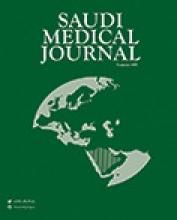Abstract
OBJECTIVE: To analyze the pre-treatment cephalometric features in Saudi adults with bimaxillary protrusion and to develop cephalometric standards to clarify the overall presentation of this malocclusion for clinicians.
METHODS: A descriptive retrospective study was designed in which lateral cephalometric radiographs of 60 individuals with Class I skeletal and dental relationship and decreased interincisal angle were collected between June 2007 and December 2008 at the Orthodontic Clinic, College of Dentistry, King Saud University, Riyadh, Kingdom of Saudi Arabia. Radiographs were studied and compared to those of 60 individuals with similar skeletal and dental relationships, but with normal interincisal angle. The measurements were calculated electronically using Dolphin’ software. The data were analyzed using the t-test.
RESULTS: Saudi individuals with bimaxillary protrusion had a vertical skeletal pattern that is similar to that of the control group, however, they demonstrated increased procumbency of the upper and lower lips. Comparing females to males with bimaxillary protrusion revealed significant increase in male lip thickness. On the other hand, no significant difference was detected in the amount of lip protrusion between males and females.
CONCLUSION: Saudi subjects with bimaxillary protrusion demonstrated distinctive soft tissue features when compared to the control group and to other ethnic groups with bimaxillary protrusion.
- Copyright: © Saudi Medical Journal
This is an open-access article distributed under the terms of the Creative Commons Attribution-Noncommercial-Share Alike 3.0 Unported, which permits unrestricted use, distribution, and reproduction in any medium, provided the original work is properly cited.






